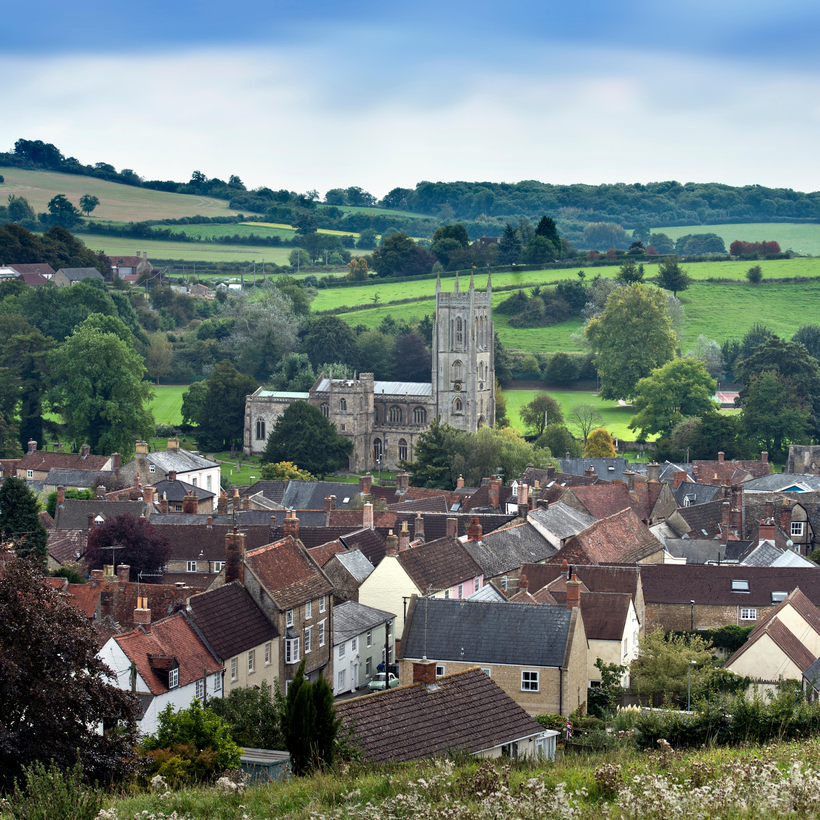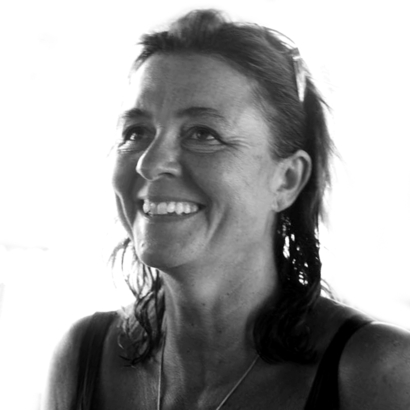“Is this it?” For a town regularly hyped by the media (it’s among the best places to live in England, according to the Daily Mail), the little town of Bruton, in South Somerset, doesn’t look like much at first glance. It hides its charms behind a forbidding, dark limestone façade that dates back to the Saxon era. “Cotwolds-cute” it isn’t. When a tractor trundles down the one-lane main street, it’s an event.

Scratch deeper and there is a mysticism to the ancient town that lies between the river Brue and the 18th-century Dovecote, or watchtower, which dominates the horizon. The countryside falls away in a patchwork of small fields, stitched together with beech and hazel hedgerows, studded with hoary century-old oaks. At times, the 21st century can feel very remote.
The Stuff of Millennial Fantasy
It felt so to my husband, the photographer Don McCullin, who relocated here in the 80s. His neighbors then, landowners of some 400 acres, walked about in sackcloth, eschewed electricity and running water, and preferred to sleep outside with their cows. When I married him 20 years later, there was not a whiff of a cappuccino to be had in town. One newcomer, who had the cheek to buy and then modernize a local pub, the Three Horseshoes, was blacklisted in the customary country way—with a dead badger, nailed to his door.

In 1959, escaping America and all of its excesses, John Steinbeck holed up for nine months at Discove, a wonky thatched cottage outside Bruton. From his desk, he could see the needle silhouette of Glastonbury Tor, the hill topped by a roofless tower where King Arthur was rumored to have once sought safe haven. Steinbeck’s sense of self-sufficiency and contentment grew, he wrote, from chopping logs and sowing lettuce seeds. He enjoyed the insularity of a place whose natives hadn’t even ventured 20 miles away to the coast, let alone concerned themselves with the seismic social changes and the McCarthyism rocking 1950s America.
Bruton’s bucolic peace and quiet, along with its palpable sense of the past, is evidently also the stuff of millennial fantasy. And the pandemic has only accelerated this. Londoners who once loved to spend wild and wine-filled weekends at Babington House, Soho House’s nearby outpost, now happily pull on their Hunter boots and check into the Newt, in Somerset, a newish country hotel known for its beekeeping and cider-making courses. The Newt’s new Farmyard Hotel, opening this month, expands the shiny empire of this garden-orchard-hospitality complex, brought to the sticks by the South African entrepreneurs of Babylonstoren fame.

This insatiable hunger for backcountry skills also plays out at Durslade Farm, an art-gallery complex that includes the six-bedroom, art-filled Farmhouse, available to rent from the owners of the Hauser & Wirth gallery. Durslade’s exhibitions and contemporary-art collections, Piet Oudolf–designed garden, and recently opened farm shop all helped put Bruton on the map. There are waiting lists for “Unhooked” fishing or butchery days with Steve Horrell, who runs the Roth Bar & Grill at Durslade with his wife, Jules. Rustic pastimes like open-fire cooking, spoon-whittling, and foraging have become more popular than wild Friday nights of “unplugged” music. Once upon a time, local musicians such as Dominic Greensmith, from Reef, or Danny Goffey, from Supergrass, would jam exuberantly into the night here. Now they are more likely to be up at first light, making jam.
During the pandemic, urban sophisticates have decamped to the region en masse. Phoebe Philo, formerly of Céline, is designing an arboretum on her estate outside the town. Journalist and television presenter Mariella Frostrup now rescues chickens and hands out jars of homemade wild-garlic pesto. Ben Goldsmith, the financier brother of Jemima Khan and a poster boy for the rewilding movement, is campaigning to re-introduce beavers to the local wildlife mix.
An Embarrassment of Riches
A recent spate of retail outlets selling the heritage-and-craftsmanship concept have migrated from London’s Notting Hill to Bruton’s High Street. The latest arrival is Cabbages & Roses, a boutique from former Vogue editor Christina Strutt. Meanwhile, visitors can hole up at Number One Bruton, the hotel that opened just before the pandemic. Higgledy-piggledy corridors, creaky floorboards, and jostling rooftops provide a romantic backdrop for botanical wallpapers by William Morris and Pierre Frey.

Design touches reflect the work of friends and local talent: the rainbow-colored armchair was donated by jewelry designer Solange Azagury-Partridge, a familiar glamorous figure in town, and the leather rack and key tags were custom-made by another West London refugee, leather craftsman Bill Amberg. There’s a housewarming gift—a floral mural—from Kaffe Fassett, and an eye-catching mantelpiece of broken china by former New Yorker Candace Bahouth. And it’s all for sale.
Once upon a time, local musicians such as Dominic Greensmith, from Reef, or Danny Goffey, from Supergrass, would jam exuberantly into the night here. Now they are more likely to be up at first light, making jam.
In the kitchen, the appropriately named Merlin Labron-Johnson is a wizard, conjuring magic out of marrows. His predominantly vegetarian restaurant, Osip, has a prix fixe menu , full of sustainably sourced ingredients. It has certainly tapped the Zeitgeist; a Michelin star was awarded within five short months.
At the Old Pharmacy, Merlin’s new deli, former chancellor of the Exchequer George Osborne can be found queuing for a fist of samphire, a vegetable similar to baby asparagus. A newcomer to Bruton, Osborne still looks too laundered and polished to be walking along the mud-caked river.
But he doesn’t really need to adapt to country life. Everything that he once enjoyed at the best restaurants in London is available here, fresh from the farm: squeaky mozzarella from Somerset’s own buffalo herd, organic cheddar from Westcombe and Godminster, rosé from the vineyards near Glastonbury, an apple brandy made by Julian and Diana Temperley, whose daughter, Alice Temperley, is a well-known fashion designer. There are also truffles foraged from the woodlands where King Alfred defended the kingdom against the Vikings.

This is the new gastronomic heartland of England. Its newfound status is underlined by the mushrooming, between lockdowns, of five farm shops, where wild cèpes can cost as much as a filet mignon or a Burberry throw. Teals has a “dog jog” field, a charging station for electric S.U.V.’s, and even a food bank that serves the community. Take the Duke of Somerset’s new gastro pub, the Bradley Hare, outside Bruton—it is the community veg patch there, alongside skittles and cricket, that makes the sell.
The woman who really changed the fortunes of the town is dynamo Catherine Butler. When she opened At the Chapel, her restaurant, hotel, gallery, and bakery, in 2008, she created a cultural platform for debate and community, and kick-started a market for local producers and makers.
Butler modestly denies that the buzz and popularity of Bruton grew from her original and indefatigable sense of purpose and vision. She insists that Bruton’s pull goes deeper than gastronomy, the sense of community, nature, heritage, or tradition. Bruton’s magnetic force, she claims, is due to its being at the intersection of important ley lines—a kind of energetic vortex—that connects or aligns Bruton’s renowned Dovecote directly to the ancient sacred sites of Avebury, Glastonbury Tor, and even across the Channel in northern France, to Mont-Saint-Michel. There are still some who will regard this notion as pseudo-science and New Age bunkum, she smilingly concedes, but in Bruton, and in the heartland of Arthurian legend that is Somerset, magic and mythology always bite deep.
Catherine Fairweather is a West Country of England–based writer


